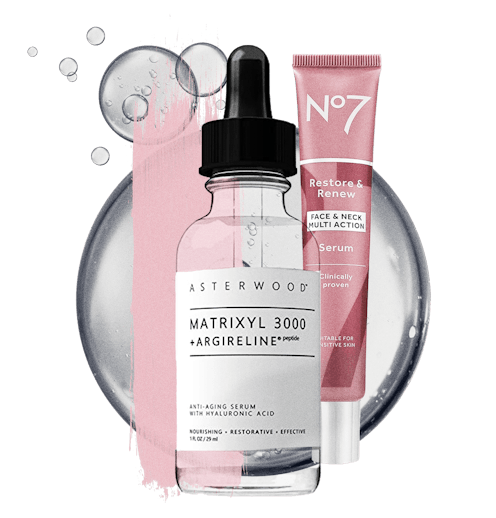(Back To Basics)
If Fine Lines Are A Sore Spot, Matrixyl 3000 Can Help
Smooth skin ahead.

With new products, brands, and categories popping up every day, beauty can be a bit overwhelming. Back to Basics is our rudimentary beauty series that serves as your crash course on the science behind some of the best formulations in the game. This week, we’re taking a look at Matrixyl 3000 for your skin.
Things move fast in skin care, and given the never-ending quest for maintaining a youthful complexion, it’s not hard to understand why. From reviving rituals with ancient ingredients to potent laboratory-made actives, anti-aging products are launching at a dizzying rate. But Matrixyl 3000 is one synthesized ingredient that’s managed to cut through the noise. As a trademarked synthetically produced peptide blend, it has made waves due to its unique ability to repair from within the cell. In fact, there are many benefits of Matrixyl 3000 for skin, including a visible reduction in the appearance of wrinkles, fine lines, and even inflammation.
According to Dr. Ava Shamban M.D., a Los Angeles-based board-certified dermatologist, and founder of Ava MD and SKINFIVE clinics, “The peptides in Matrixyl 3000 work effectively to stimulate the production of collagen and elastin within the cell, staving off signs of premature aging, and improving the overall texture of the skin.”
Yet, despite its results, and veteran status in the industry, many people are still completely unfamiliar with the ingredient. But if you’re a skin care enthusiast, you’ve probably noticed the recent chatter around the skin benefits of peptides as of late. But much of that excitement can be attributed to Matrixyl 3000’s creation 20 years ago. Ahead, TZR tapped three leading dermatologists for the lowdown on this powerhouse peptide blend — from its benefits, how it’s used, and even the products to easily add to your routine.
What Is Matrixyl 3000?
According to board-certified dermatologist and cosmetic surgeon at Art of Skin MD, Melanie Palm, M.D., Matrixyl 3000 is a trademarked blend of two synthetic peptides — palmitoyl tripeptide-1 and palmitoyl tetrapeptide-7 — that has been shown to have anti-aging benefits. To better understand how Matrixyl 3000 works to actively improve wrinkles, it’s useful to know the basics behind its structure. Like all peptides, Matrixyl 3000 is just a short portion of the amino acids used to build proteins. The two specific peptides which compose it are considered “messenger” peptides (or matrikines) because their primary function is to regulate cellular activities such as repair and renewal.
By sending these messages, Matrixyl 3000 has been proven to restore the skin barrier as well as improve the extracellular matrix. According to Dr. Kiran Mian, D.O.,F.A.A.D., medical and aesthetic dermatologist at Hudson Dermatology & Laser Surgery, it also signals an increase in collagen synthesis to decrease fine lines and wrinkles, refine the skin, and better skin elasticity.
What Are The Skin Benefits of Matrixyl 3000?
Along with its anti-aging properties, Matrixyl 3000 is known for its ability to ease inflammation and calm common signs of irritation. This, as Dr. Mian notes, “makes it ideal for sensitive skin types that have trouble tolerating other anti-aging compounds like retinoids.” But they are not the only ones who will benefit from the use of this chemically synthesized blend. Matrixyl 3000 works directly at the cellular level to reduce and prevent visible signs of damage to the skin’s surface like age spots.
What Are The Side Effects Of Matrixyl 3000?
With so many benefits, you’ll be happy to know that Matrixyl 3000 is safe to use on all skin types and plays well with most key ingredients in skin care products. But you should still be cautious when beginning to use it, as overuse of any product can cause minor issues. With that said, Dr. Palm suggests conducting a spot test to be sure it doesn’t cause an allergic reaction.
Dr. Shamban tells TZR that despite being routine friendly, Matrixyl 3000 does not work as effectively when vitamin C is present. In that vein, it should be used at a separate time from the active, as well as chemical exfoliants such as BHAs and AHAs to ensure its potency and avoid irritation.
How To Use Matrixyl 3000 In Your Skin Care Routine
Dr. Shamban says that Matrixyl 3000 can easily be incorporated into both daily and nightly skin care routines. “It’s not counterintuitive with the sun and does not have any reactivity factors that relegate the time it should be applied,” she says. However, she does note that skin receptors are designed to turn on key functions at optimized times of the 24 circadian cycle, so nightly use could be greatly beneficial.
“This peptide works similarly to retinol in terms of wrinkle reduction and is good for the skin’s repair cycle, which occurs at night, so it’s a good idea to begin adding a Matrixyl 3000 product in evening routines,” she shares.
But exactly how you incorporate it will depend most on the formulation of the product you choose . Most often, you will find Matrixyl 3000 in serums which should be applied to freshly cleansed skin and followed with a moisturizer. “To apply, place a few drops onto the skin and gently massage in small circles up and out including dabbing under the eye and any surrounding problem areas,” says Dr. Shamban
Alternatively, there are some moisturizers that contain the peptide complex which can replace your standard nighttime cream. Below, a few Matrixyl 3000 products to incorporate into your current regimen.
Shop Matrixyl 3000 Products
This article was originally published on